If you were expecting some kind of sun sign nonsense, forget about it. This is real astrology for the real world. If it's real astrology for yourself that you want, you can get it by phone or in print. And if you need help deciphering the astrological glyphs in the graphics accompanying this article, see Astroglyphs: Astrological Symbols Guide. Please note: this forecast is expressed in terms of Universal Time (UT).
Learn from yesterday, live for today, hope for tomorrow.
-- Albert Einstein
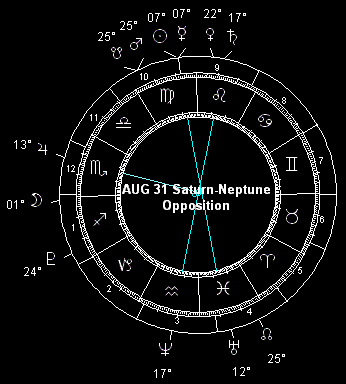 The celestial themes at work throughout the year promise that 2006 is a watershed moment in history. I don't know that the day will soon come when we'll be able to say with certainty, in retrospect, that there was one particular event or one specific moment when the tide of time changed in 2006. But looking back on history, and looking up at the unfolding signs in the sky - some of which haven't been seen since the middle of the first millennium of the Common Era - I know there's something coming up in 2006 that's world-historic. This is the year that a unique configuration of Jupiter, Saturn and Neptune takes place, the likes of which has not been seen since 536.
The celestial themes at work throughout the year promise that 2006 is a watershed moment in history. I don't know that the day will soon come when we'll be able to say with certainty, in retrospect, that there was one particular event or one specific moment when the tide of time changed in 2006. But looking back on history, and looking up at the unfolding signs in the sky - some of which haven't been seen since the middle of the first millennium of the Common Era - I know there's something coming up in 2006 that's world-historic. This is the year that a unique configuration of Jupiter, Saturn and Neptune takes place, the likes of which has not been seen since 536.
So there'll be no misunderstanding, please be advised that I'm not making some dire Cassandra-like prophecy of the Apocalypse, as so many astrologers and mystics have done down through the years - always, to their shame and humiliation, or at the very least their professional embarrassment. I've been doing astrology professionally, and writing it for a national and international audience, for over thirty years now. Never in that time have I been a doomsayer, nor am I now. Often - most recently in the case of the Y2K hysteria and the Great Alignment of 2000 - I have been one of the few astrological voices of reason, cautioning that it is not only wrong but in fact vain to imagine or warn that the world will end in our time. It is a flaw in human nature, a kind of hubris that causes people to imagine that they're present for the end of history. (People who can't handle mortality seem to feel better about it by projecting it on the entire planet. Go figure.)
Was it the end of the world when the Christian Church split, when the Roman Empire fragmented, when the Roman Legions sacked Jerusalem? It may have seemed so, to some people at the time. But life went on, and civilization survived - building on the remains of what had once been lofty and supreme. So it is with all these end of the world scenarios: the world as we know it is always ending, because life is change. Some few changes, viewed from the perspective of history, are world-historic in nature. They generally aren't recognized as such, at the time they take place. But in the fullness of time, once the implications are evident, people look back and point to the moment when the world changed. The murder of Archimedes, Gaius Julius Caesar invading Gaul, Columbus landing in the New World, the drilling of the first oil well, the invention of the first automobile, the Wright Brothers flight . . . they all changed the world, but not one of these turning points was widely recognized as historic at the time. And so it will be with 2006.
The world never changes in the blink of an eye. A single event may take seconds or minutes or hours to transpire, and in the process can initiate a chain of events that alters history. But the instant that launches the transformation which changes the world is only the beginning, not the change itself. Really fundamental change is a process that is developed and recognized in the fullness of time; not in an instant. This year's Jupiter-Saturn-Neptune configuration, momentous as it is, is part of an unfolding cycle that dates back several years already. Years more will pass before the cycle winds down.
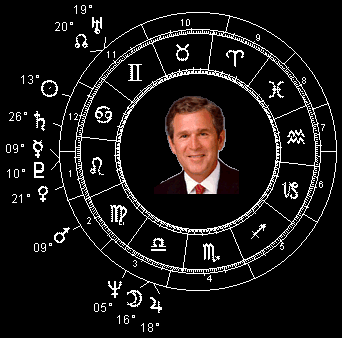 Jupiter's quadrature (square aspect, a 90° arc) from Scorpio to the Saturn in Leo opposition to Neptune in Aquarius is the centerpiece of what's happening in the heavens in 2006. It's a three-pronged configuration that astrologers call a T-square. A T-square, as astrological configurations go, is aptly named. It's a T-shaped pattern, a draftsman's T-square in the sky: two points, each at opposite ends of the heavens, with a third point at right angles to (ninety degrees from) the other two. Jupiter's square to Saturn forms first in December 2005, and then again in June and October 2006; while the Giant Planet's square to Neptune is exact in January, March, and September. In the meantime, Saturn's opposition to Neptune is exact at the end of August in 2006, and again in February and June 2007. Exact alignment dates aside, these three gas giants are within a few degrees of their T-square configuration off and on from late November 2005 through January 2006, and again from late July into October of 2006.
Jupiter's quadrature (square aspect, a 90° arc) from Scorpio to the Saturn in Leo opposition to Neptune in Aquarius is the centerpiece of what's happening in the heavens in 2006. It's a three-pronged configuration that astrologers call a T-square. A T-square, as astrological configurations go, is aptly named. It's a T-shaped pattern, a draftsman's T-square in the sky: two points, each at opposite ends of the heavens, with a third point at right angles to (ninety degrees from) the other two. Jupiter's square to Saturn forms first in December 2005, and then again in June and October 2006; while the Giant Planet's square to Neptune is exact in January, March, and September. In the meantime, Saturn's opposition to Neptune is exact at the end of August in 2006, and again in February and June 2007. Exact alignment dates aside, these three gas giants are within a few degrees of their T-square configuration off and on from late November 2005 through January 2006, and again from late July into October of 2006.
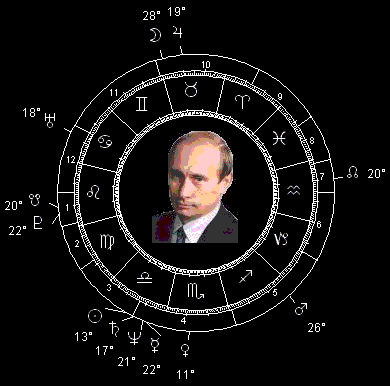 Because of its historic rarity, this is a planetary configuration of universal importance. But it's also of particular interest to everyone whose natal horoscope features an emphasis on the fixed signs; namely Taurus (the empty point of what would be a Grand Cross pattern), Leo (where Saturn is), Scorpio (where Jupiter transits), and Aquarius (the sign Neptune occupies in the T-square). Noted politicians born with this emphasis include US President Bush (Mercury, Venus and Pluto in Leo), UK Prime Minister Tony Blair (three fixed signs occupied in his natal horoscope) and Russian President Vladimir Putin (all four fixed signs occupied) - to name just a few. Check your own chart! This applies as well to nations as it does to people. National charts with prominent fixed sign placements include China, Israel, Japan, Russia, the UK and the USA (the Constitution Effective chart for March 4, 1789); also the US Federal Reserve - again, to name just a few. (Don't even raise the old signs-versus-constellations red herring. See my online article laying that myth to rest.)
Because of its historic rarity, this is a planetary configuration of universal importance. But it's also of particular interest to everyone whose natal horoscope features an emphasis on the fixed signs; namely Taurus (the empty point of what would be a Grand Cross pattern), Leo (where Saturn is), Scorpio (where Jupiter transits), and Aquarius (the sign Neptune occupies in the T-square). Noted politicians born with this emphasis include US President Bush (Mercury, Venus and Pluto in Leo), UK Prime Minister Tony Blair (three fixed signs occupied in his natal horoscope) and Russian President Vladimir Putin (all four fixed signs occupied) - to name just a few. Check your own chart! This applies as well to nations as it does to people. National charts with prominent fixed sign placements include China, Israel, Japan, Russia, the UK and the USA (the Constitution Effective chart for March 4, 1789); also the US Federal Reserve - again, to name just a few. (Don't even raise the old signs-versus-constellations red herring. See my online article laying that myth to rest.)
In particular, the middle of the fixed signs is where the 2006 T-square is focused. These are the so-called "cross-quarter" points, midway between the solstices and equinoxes, and they have been held in special regard from ancient times. The symbols of these signs are mentioned in the Book of Ezekiel: the man (Aquarius), the lion (Leo), the ox (Taurus) and the eagle (an old symbol for Scorpio). The great modern astrologer Dane Rudhyar called them "the Gates of Avataric Descent", meaning the points through which spiritual energy from the cosmos enters the earthly plane. From Neolithic times, they have been regarded as having special spiritual significance, memorialized on Imbolc (aka Candlemas and Ground Hog Day at middle Aquarius, approximately February 1), Beltane (May Day, middle Taurus), Lammas (approximately August 1, middle Leo), and Samhain (middle Scorpio on November 1, All Saints Day, the eve of which is Halloween). Due to calendar changes down through the centuries, the ancient festival dates are off by a few days from the actual midpoints between solstices and equinoxes in the modern Gregorian calendar; but that's beside the point - which is that these "cross-quarter" points are not just ordinary zones of the sky. For thousands of years, and continuing today in the form of Catholic holy days and neo-pagan festivals, people have gathered for spiritual empowerment on these dates.
This year, anyone who participates in any of these traditions will do so under the aegis of the great T-square in the sky. Midnight ceremonies are singled out in particular, because the three planets in the T-square will be at or near the horizon and meridians at the time - rising, setting, directly overhead or directly below at the moment. I won't presume to preach, but this much I can see: that when people congregate on these days this year, their collective consciousness will be gathered and focused at a time when the cosmic consciousness is uniquely focused on Planet Earth. One can only guess at what that might mean, in terms of a change of heart, mind and spirit. Will the revelation that worldly power is an illusion crush proud spirits, and exalt the humble? Perhaps. Will the revelation that collective power is ultimately mindless and heartless change peoples' minds and hearts? We live in hope. Will any of this result in a permanent spiritual rebirth? Don't be silly! Illusions will be shattered here and there, and for a time some people will glimpse the truth: that we are not we, we are I. Then the dream takes over again, the sleepwalking resumes, the game starts once more, and everything is as it was - only different, because it's always changing.
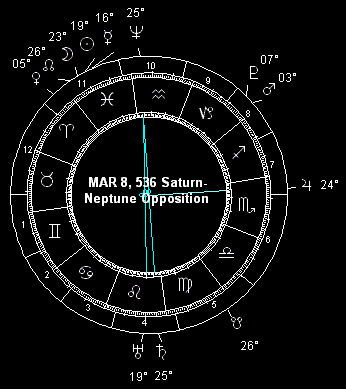 The off-and-on 2005-2006 T-square includes the first square to occur with Neptune in Aquarius and Jupiter in Scorpio since the 1839-1840 triplet; the first Jupiter-Saturn square from Scorpio to Leo since 1946, and the first triplet with this sign configuration since 417; also the first opposition from Saturn in Leo to Neptune in Aquarius since 1683-1684 (the first three-peat opposition of these planets in these signs since 1181-1182). The 1181-1182 Saturn-Neptune opposition from Leo to Aquarius happened to be part of a T-square configuration involving all three planets, only with Jupiter in Taurus instead of Scorpio. (It also happened to herald the end of the Anasazi civilization in Chaco Canyon.) The last Jupiter-Saturn-Neptune T-square in Scorpio, Leo and Aquarius respectively dates all the way back to 536: nearly 1,500 years have passed since the last appearance of the particular planetary configuration that is so prominent in the heavens from late 2005, off and on throughout 2006.
The off-and-on 2005-2006 T-square includes the first square to occur with Neptune in Aquarius and Jupiter in Scorpio since the 1839-1840 triplet; the first Jupiter-Saturn square from Scorpio to Leo since 1946, and the first triplet with this sign configuration since 417; also the first opposition from Saturn in Leo to Neptune in Aquarius since 1683-1684 (the first three-peat opposition of these planets in these signs since 1181-1182). The 1181-1182 Saturn-Neptune opposition from Leo to Aquarius happened to be part of a T-square configuration involving all three planets, only with Jupiter in Taurus instead of Scorpio. (It also happened to herald the end of the Anasazi civilization in Chaco Canyon.) The last Jupiter-Saturn-Neptune T-square in Scorpio, Leo and Aquarius respectively dates all the way back to 536: nearly 1,500 years have passed since the last appearance of the particular planetary configuration that is so prominent in the heavens from late 2005, off and on throughout 2006.
This has been building for years now. Neptune's current sojourn in Aquarius - the first leg of the tripod - began back in 1998, during the dot-com craze (when the NASDAQ first crossed 2,000) and Russia's ruble collapse and debt default. Then came the Jupiter-Saturn conjunction in Taurus which started the current cycle of these two planets back in 2000 - which cycle comes to its first critical quadrature as Jupiter squares Saturn from Scorpio, the sign opposite the Taurus conjunction. This quadrature, with its roots in the Taurus conjunction and its incorporation into the great T-square of 2006, emphasizes structural change in the world financial system - a system which dates back, arguably, to the last triple conjunction of Jupiter and Saturn in Taurus in the 1940s; which, incidentally, was the first such triple conjunction since the one in 562-561 BCE. Interesting coincidence: the current world financial system dates back to the establishment of the US dollar as the global reserve currency back in the 1940s, while history records the first use of gold coinage as an innovation by King Croesus, ruler of Lydia from 560 to 546 BCE. Suggestion: buying gold and silver bullion coins whenever there's a price dip might just make a person, as the saying goes, "rich as Croesus."
The next threshold was reached on April 12, 2003 (the day Neptune moved to within five degrees of the place it occupies when the first Saturn-Neptune opposition in the triplet occurs): the SARS outbreak, the first human cases of H5N1 Bird Flu, Gulf War II, and the worst week in US tornado history. Next up was Saturn's slide into Leo on July 16, 2005: two of the three planets in the T-square had moved into the requisite signs, as the Atlantic hurricane season was on its way to becoming the worst on record (including Hurricane Katrina, the costliest and deadliest natural disaster in US history and the immediate cause of the US federal government being overwhelmed by a natural catastrophe of apocalyptic proportion); and the US real estate bubble was topping off, threatening the dollar-denominated global financial system. The last major piece of the tripartite puzzle fell into place as Jupiter moved into Scorpio in October, 2005 - the month of the monstrous earthquake in the Pakistan-Kashmir-India region, which killed nearly 100,000 people; as well as the uprising in France and the late season Hurricane Wilma that pounded Cuba, Cancun and Florida.
Climate upheaval, disease, political and economic as well as social decay: these are central themes at a great many turning points in history. The thing about such moments is that they generally aren't recognized as such until many years have passed; and then, in time, they are forgotten. Human beings are typically unaware of the great cycles of history. Take, for example, the so-called "Little Ice Age" that altered the course of European civilization from about the 14th to the mid 19th centuries. It killed off the Viking expansion into the New World, changed the economies of Northern Europe, and set famine and the Black Plague loose upon the continent. For hundreds of years, Europeans grew accustomed to living in near Ice Age conditions, and came to think of them as normal. Then, in the 19th Century, a period of global warming set in - as had happened before the Little Ice Age, during the Medieval Warm Period that lasted from the 10th to the 14th Century. (Climate evidence from Asia, Australia, the Americas and Africa shows that, with local variations, long term climate changes around the world corresponded to these same cycles.)
Today's so-called global warming is only the latest in a number of cyclical climate swings documented in the last couple thousand years; and not the biggest at that. Looking back at the historical record, the reappearance of the Leo-Scorpio-Aquarius Saturn-Jupiter-Neptune T-square for the first time since 536 is a most peculiar coincidence - and I use that term literally, not in the sense of mere happenstance. Climate shifts go way beyond temperature, precipitation, growing season and the like. They coincide with social, political, economic and cultural transformation (which never happens without a collapse first); with technological change (including agriculture, but often only after a famine or twenty); with pandemics (due at least in part to the combination of stress caused by famine as well as the migration of disease vectors); and speaking of migration, massive human migrations as well. If it's too soon to see that all these things are in progress in the here and now, maybe we can look back to the last time this year's T-square appeared in the sky.
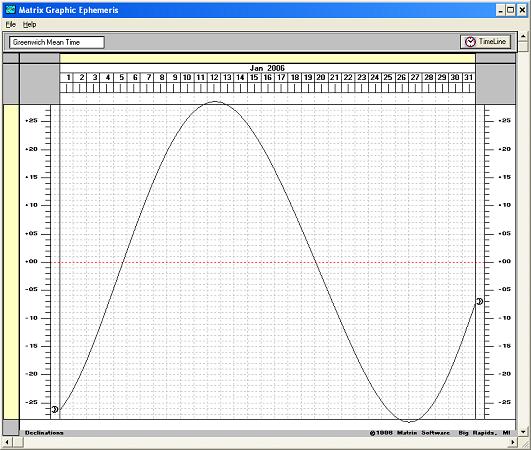 The first element of the 536 Saturn-Jupiter-Neptune T-square in Leo-Scorpio-Aquarius slid into place in 524, when Neptune entered Aquarius (as it did in 1998 in the current scenario). The Jupiter-Saturn conjunction of April 531 paralleled the May 2000 alignment of these two planets. Next up was Saturn's Leo ingress, in 533 (analogous to July, 2005 in the configuration currently in progress). Jupiter's 535 slide into Scorpio (paralleling October, 2005 in the pattern now unfolding) put the last piece of the puzzle into place. An extra factor in common during both periods is the extreme lunar declination cycle: it was peaking in 536, as it will be peaking in 2006. And that's worth a closer look, because it's such a fundamental component of the whole celestial pattern that dominates the year ahead.
The first element of the 536 Saturn-Jupiter-Neptune T-square in Leo-Scorpio-Aquarius slid into place in 524, when Neptune entered Aquarius (as it did in 1998 in the current scenario). The Jupiter-Saturn conjunction of April 531 paralleled the May 2000 alignment of these two planets. Next up was Saturn's Leo ingress, in 533 (analogous to July, 2005 in the configuration currently in progress). Jupiter's 535 slide into Scorpio (paralleling October, 2005 in the pattern now unfolding) put the last piece of the puzzle into place. An extra factor in common during both periods is the extreme lunar declination cycle: it was peaking in 536, as it will be peaking in 2006. And that's worth a closer look, because it's such a fundamental component of the whole celestial pattern that dominates the year ahead.
Like 2005, 2006 will be unusually active on the storm and seismic front. The reason, in a word, is declination - as in lunar declination, how far above or below Earth's equator the Moon will reach in its monthly cycle. Every month, Luna traces a path in the sky that swings from above (north of) to below (south of) Earth's equator. This distance above and below is measured in degrees of declination, and over its 18.6-year cycle the maximum value ranges from a low of about 18° to a high of nearly 29°. Years when there's an extreme maximum lunar declination tend to have extreme seismic and meteorological disturbances, and as I indicated a couple years ago, we're in one now.
Last year's record-breaking hurricane season surpassed a mark last set in 1933 - another year of high lunar declination maxima (averaging over 28°), and also the year of the killer California quake that long ranked near the top on the list of most expensive natural disasters in American history. We've been in the red zone since 2004, with lunar declination maxima over 27.5° since the spring of that year. We will hit the absolute peak of the current cycle (28.7°) in the spring and fall of 2006, although we were just a hair from it in late summer and early fall of 2005. With extremes still in excess of 27.5° through the summer of 2008, we'll be years getting back to what passes for normal in terms of storm and seismic disturbances. Especially when coupled with other lunar dynamics - from garden variety new and full moons to eclipses, SuperMoons and perigees (the Moon's closest approach to Earth) - these lunar declination extremes mean that even ordinary seismic and meteorological disturbances tend toward the extraordinary, throughout the next couple years or so. Regardless of other contributing factors, the spring and fall declination peaks mark periods of extreme geocosmic stress this year - times to be ready for catastrophic storms (with high winds and heavy precipitation upping the risk for floods, mudslides and the like), as well as abnormally high tides along the coast; and in seismically active regions, a surplus of moderate to severe earthquakes (Richter 5 and over) as well as volcanic eruptions.
 Apart from the staggering death toll wrought by events of this sort over these past few years of peak lunar declination extremes, catastrophes like the 2004 Asian tsunami and 2005's Hurricane Katrina and Kashmir earthquake point out the vulnerability of the world's political and economic infrastructure during the current extreme lunar cycle. (The December 26, 2004 Sumatran earthquake and subsequent killer mega tsunami occurred on the very day of the Moon reaching its maximum declination north of the equator that month. Hurricane Katrina hit the US Gulf Coast on August 29, 2005 - within a day of the Moon's northward declination maximum that month. And the October 8, 2005 Kashmir earthquake struck within a day of that month's south declination extreme.) All three are case studies of how governments can be overwhelmed by the forces of nature; and how regional, national and international economic systems can be jeopardized by the impact of natural catastrophe - not to mention a human engineered catastrophe, such as weapons of mass destruction could create.
Apart from the staggering death toll wrought by events of this sort over these past few years of peak lunar declination extremes, catastrophes like the 2004 Asian tsunami and 2005's Hurricane Katrina and Kashmir earthquake point out the vulnerability of the world's political and economic infrastructure during the current extreme lunar cycle. (The December 26, 2004 Sumatran earthquake and subsequent killer mega tsunami occurred on the very day of the Moon reaching its maximum declination north of the equator that month. Hurricane Katrina hit the US Gulf Coast on August 29, 2005 - within a day of the Moon's northward declination maximum that month. And the October 8, 2005 Kashmir earthquake struck within a day of that month's south declination extreme.) All three are case studies of how governments can be overwhelmed by the forces of nature; and how regional, national and international economic systems can be jeopardized by the impact of natural catastrophe - not to mention a human engineered catastrophe, such as weapons of mass destruction could create.
Economic factors associated with a peak lunar declination maximum are not necessarily tied to natural disasters, although they can certainly be exacerbated by them. Consider that the last peak in the 18.6-year lunar declination cycle came in 1987: a change at the helm of the US Federal Reserve, followed by a stock market crash. Déjà vu all over again, Mr. Bernanke? Look back to the 1929 crash: the Moon's peak declination topped 27.5° that month, edging into the red sector. It's possible that cataclysmic forces of nature - climate change, with or without a volcanic or cosmic impact trigger - can tip the economic system into chaos. But it's certainly not necessary. Social, political and economic systems are perfectly capable of falling off a cliff with or without a natural disaster to push them over the edge.
 It's clear what happened the last time this year's T-square made an appearance in the sky: volcanic winter, with unusually low temperatures and snow in the summer; floods in arid regions; crop failures and stunted tree growth (the latter documented by tree ring studies). Volcanologist Ken Wohletz has reviewed the geological evidence and concludes that the Dark Ages and indeed a whole historic shift in global human civilization were triggered by a volcanic eruption (where Krakatoa is now) in 535, which initiated a cycle of global cooling on the order of "5 to 10 degrees C or more lasting over 10 to 20 years," (followed by) "subsequent global warming with remaining water vapor acting as a greenhouse gas and decreased ozone." (See Were the Dark Ages Triggered by Volcano? by Ken Wohletz, Los Alamos National Laboratory.) It's just as clear that we're now in another time of increasing natural disasters and climate disruption. You don't need to recognize that both time periods have the same T-square and same lunar declination peak to see the similarities, you just have to pay attention to what's been happening these past few years. It won't get better in 2006, so have your emergency supplies handy: non-perishable foods, off-grid energy supplies, and off-grid water are bare minimum requirements. Think about a cash stash, and remember what's really cash.
It's clear what happened the last time this year's T-square made an appearance in the sky: volcanic winter, with unusually low temperatures and snow in the summer; floods in arid regions; crop failures and stunted tree growth (the latter documented by tree ring studies). Volcanologist Ken Wohletz has reviewed the geological evidence and concludes that the Dark Ages and indeed a whole historic shift in global human civilization were triggered by a volcanic eruption (where Krakatoa is now) in 535, which initiated a cycle of global cooling on the order of "5 to 10 degrees C or more lasting over 10 to 20 years," (followed by) "subsequent global warming with remaining water vapor acting as a greenhouse gas and decreased ozone." (See Were the Dark Ages Triggered by Volcano? by Ken Wohletz, Los Alamos National Laboratory.) It's just as clear that we're now in another time of increasing natural disasters and climate disruption. You don't need to recognize that both time periods have the same T-square and same lunar declination peak to see the similarities, you just have to pay attention to what's been happening these past few years. It won't get better in 2006, so have your emergency supplies handy: non-perishable foods, off-grid energy supplies, and off-grid water are bare minimum requirements. Think about a cash stash, and remember what's really cash.
Perhaps the volcano was a contributing factor, the first link in a chain of events that goes from climate change to crop failure to hunger to migration and pandemic disease. Historians will argue the case forever. Whatever the cause, there were fundamental cultural, economic and political changes at work in 536. "The last Roman Emperor," Justinian, was on the throne in Constantinople, and political unity was predicated on religious orthodoxy, which was enforced by theocratic legislation and outright persecution. Volcanologists are apt to think of volcanic eruptions as causing the other changes. Astrologers see it differently: it's all just different manifestations of the same thing. One doesn’t cause the other; each is just a different facet of the same thought in the universal mind. Likewise, the T-square doesn’t cause volcanic eruptions, crop failure, disease, religious persecution, political upheaval or economic restructuring. They just happen together - and we'd all do well to be ready for them.
Jupiter in Scorpio squaring a Saturn-Neptune opposition from Leo to Aquarius is a rare and momentous configuration. It means a crisis of confidence, a loss of faith in authority and tradition. The empty 'fourth chair' in the T-square is Taurus, symbolic of all that is valued and loved and cherished by human beings. Money is part and parcel of this, because it's the medium of exchange we use to get those things we cannot or will not get any other way. We may love apples, but having a whole bushel of them will not make us happy, because most of them will go bad before we can get 'round to eating them. Money won't rot, and we can use it to buy the freshest apples as we want them. It's the medium of exchange we use to trade for the things we want. When King Croesus of Lydia introduced gold and silver coinage following the triple Taurus conjunction of Jupiter and Saturn in 562-561 BCE, it was an innovation soon imitated around the world. People found it reassuring to have standardized coins comprised of a known amount of a precious metal. If someone gave you a gold Croesus, you knew what you had: eight grams of pure gold, worth a bit over $125 US at current spot prices as I write this.
Sovereigns down through history, alas, discovered a convenient way of stealing money for themselves, their friends and their pet projects. By debasing the coinage, they could literally take money out of the pockets of their subjects. Originally, this was done either by shrinking the coin, or by alloying precious metals like gold and silver with base metals (e.g. copper, zinc, nickel, etc.). The coins weighed more or less the same, and to the untrained eye looked pretty much the same at first. Unfortunately, there were now more coins in circulation, and they were being used to buy essentially the same amount of goods - productivity gains being slow to materialize prior to the Industrial Revolution. The result, of course, was inflation: you paid more to get the same thing, and every year the cost went up some more.
Note how inflation and debasing the coin of the realm go hand in hand. It just sounds a little less like theft if you call it inflation rather than debasement or devaluation. But in any event you took your lumps, because the sovereign used a carrot and stick combination to keep you in line. On the one hand, you (and perhaps your whole village) could be killed for complaining. And on the other hand, bread and circuses - what US political jargon calls entitlements today - made a fine distraction; just the trick to make the sovereign seem like a pretty good fellow after all. The introduction of fiat currency - not backed by any precious metal - made the sovereign's con job supremely easy. A currency unconstrained by anything of real value could be constantly debased simply by printing more and more of the stuff. Promises and paper are cheap, after all. Inevitably, the day would come when the debased (indeed, ultimately baseless) currency was seen for what it really was: worthless. A greater or lesser restructuring of the financial system followed, with all the unpleasantness and disorder that implies.
The important thing to realize is that this is no Economics 101 parable. It has happened many times around the world, throughout history. Like in 64 CE, when Nero started debasing the Roman coinage. In his reign alone, the silver content of Roman coins was reduced by 10%. By 286, when the east-west split ended the Roman Empire as a single political unit, the once pure silver denarius was down to only five percent silver. (Notice the parallel: currency gets debased, Empire disintegrates.)
Kublai Khan established the pattern of debasement we see today. After conquering China in 1279, he confiscated all gold and silver and replaced them with a paper currency. Anyone who didn't go along with the new order faced the death penalty. And then, absent any standard of real value (e.g. a precious metal standard), Kublai Khan and his successors were free to debase the currency to their heart's content, as they stole the wealth of the people. By the 15th Century, China's paper currency had been debased to the point of worthlessness, and the paper money was more or less abandoned.
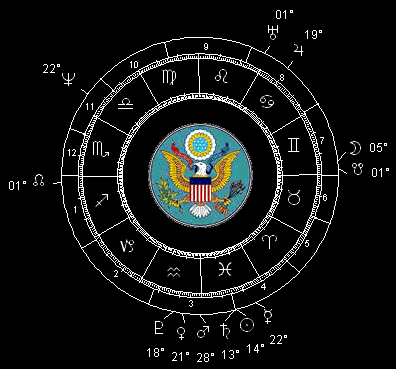 Except for the death penalty part, the Khan's policy wasn't all that different from what US President Franklin Roosevelt decreed in 1933, when he ordered all US citizens to turn in their gold coins, gold bullion and gold certificates. (Nobody got executed for disobeying Roosevelt's decree, but anyone caught violating it was subject to a $10,000 fine.) Of course it's unconstitutional for the government to seize the property of US citizens without compensation, so Roosevelt ordered that all the gold seizures be repaid in paper currency - at the rate of one paper dollar for three dollars worth of gold. Following the 1940-1941 triple Jupiter-Saturn conjunction in Taurus, the US dollar became the de facto currency of the world as a result of the Bretton Woods Agreement. When President Nixon took the US dollar off the gold standard in 1971, it became an absolute fiat currency, based on nothing more than electronic debits and credits. Completely divorced from anything of real value, each dollar that Roosevelt handed out for every three dollars worth of gold he confiscated is now worth less than 7 cents; which is to say that it takes over $14 in 2006 to buy what one dollar bought in 1934.
Except for the death penalty part, the Khan's policy wasn't all that different from what US President Franklin Roosevelt decreed in 1933, when he ordered all US citizens to turn in their gold coins, gold bullion and gold certificates. (Nobody got executed for disobeying Roosevelt's decree, but anyone caught violating it was subject to a $10,000 fine.) Of course it's unconstitutional for the government to seize the property of US citizens without compensation, so Roosevelt ordered that all the gold seizures be repaid in paper currency - at the rate of one paper dollar for three dollars worth of gold. Following the 1940-1941 triple Jupiter-Saturn conjunction in Taurus, the US dollar became the de facto currency of the world as a result of the Bretton Woods Agreement. When President Nixon took the US dollar off the gold standard in 1971, it became an absolute fiat currency, based on nothing more than electronic debits and credits. Completely divorced from anything of real value, each dollar that Roosevelt handed out for every three dollars worth of gold he confiscated is now worth less than 7 cents; which is to say that it takes over $14 in 2006 to buy what one dollar bought in 1934.
It's arguably true, as today's economists are wont to say, that productivity gains and the growth of national wealth are best served and represented by a flexible currency. Gold and silver being relatively inflexible in comparison to fiat currency, the argument goes, we're better off without a precious metal foundation to our currency. Who's better off? Nero, Khan, Roosevelt, Nixon and their like had glib and seductive answers. The masses swallowed it hook, line and sinker for generation after generation - until the illusion became unsustainable. The great 2006 T-square speaks of the illusion collapsing. Whether it's a natural or man-made catastrophe that initiates the collapse of the illusion, a debt crisis, or just the refusal to continue accepting an obviously bankrupt fiat currency, this year's Saturn-Jupiter-Neptune configuration says the day of reckoning is at hand.
 I'm not saying the present dollar-denominated global financial system will collapse all at once this year. The collapse has already begun, arguably around the same time as the run-up to this year's T-square (i.e. back in 1998). As long as it remains in the interest of major dollar holders like China and Japan to continue financing US debt in order to stimulate their own economies, they'll do so. The 2006 T-square suggests that the central banks of these two nations (and others) will start dumping those dollars in one way or another this year - buying gold, military spending, buying up US assets, etc. But it will take a dozen or more years - probably until the 2020 Great Chronocrator (Jupiter-Saturn conjunction) - for this process to work itself out.
I'm not saying the present dollar-denominated global financial system will collapse all at once this year. The collapse has already begun, arguably around the same time as the run-up to this year's T-square (i.e. back in 1998). As long as it remains in the interest of major dollar holders like China and Japan to continue financing US debt in order to stimulate their own economies, they'll do so. The 2006 T-square suggests that the central banks of these two nations (and others) will start dumping those dollars in one way or another this year - buying gold, military spending, buying up US assets, etc. But it will take a dozen or more years - probably until the 2020 Great Chronocrator (Jupiter-Saturn conjunction) - for this process to work itself out.
The 2006 conjunction completes the transition from earth sign to air sign Chronocrators, which shift began in 1980-1981 when a triple conjunction in the air sign Libra interrupted an unbroken series of earth sign Chronocrators that had run since 1842 (shortly before the Bank Charter Act put England on a strict gold standard for the first time). The conjunction reverted to the earth sign Taurus in 2000, but will not occur in earth signs again until the year 2577. We are witnessing the end of an era.
The practical and personal implications of the coming currency realignments are manifold. The US dollar, which has done well against many other currencies in 2005, just as I predicted, will take big hits as the T-square comes and goes in the skies of 2006. But other major currencies are no safe haven, inasmuch as their central banks are holding huge US dollar reserves. It all comes down to what it always comes down to: gold and silver. I've never been a 'gold bug' and I'm not saying to sell everything you own and convert it to gold, because you can't eat the yellow metal and it makes a ridiculous roof. But I am suggesting that it's silly not to consider accumulating gold and silver bullion coins as a safe haven in the coming days of dollar devaluation (or worse). Steadily buying bullion has been a consistently reliable way of defeating inflation down through the years, as evidenced by the price of gold in relation to the Consumer Price Index since gold was demonetized back in the 1970s. Gold stocks, too? Sure, but remember that a stock certificate is as much a promise to pay as a dollar bill. The promise is only as good as the person or institution making it. Bullion, on the other hand, is no mere representation of value. It is the very essence of value, in the material sense.

While major celestial themes vary a lot from year to year, there are always some familiar annual motifs - although even these recurrent cycles differ in detail. For example, 2006 brings a new crop of SuperMoons. SuperMoon is a term I coined in a 1979 article for Dell Publishing Company's HOROSCOPE magazine, describing what is technically called a perigee-syzygy; that is, a new or full moon (syzygy) which occurs with the Moon at or near (within 90% of) its closest approach to Earth in a given orbit. Like eclipses, there are typically four or five SuperMoons each year. For 2006, there are five. These include a trio of new moons around the end of each of the first three months of the year: on January 29 at 9° 32' Aquarius, on February 28 at 9° 16' Pisces, and the SuperMoon solar eclipse on March 29 at 8° 35' Aries. These are followed by a pair of full moons in the fall: the SuperMoon lunar eclipse on September 7 at 15° 00' Pisces, and the October 7 full moon at 13° 43' Aries. And then there are the eclipses of 2006. The March 14 lunar eclipse at 24° 15'Virgo leads this year's quartet, followed by the aforementioned March 29 SuperMoon solar eclipse and September 7 SuperMoon lunar eclipse, plus the September 22 solar eclipse at 29° 20' Virgo.
I've already mentioned this year's peak lunar declination extremes as reason enough to expect another world-class round of major seismic upsets and monster storms in 2006. The lunar declination triggers detailed in my online table of these events for the year (each being active for 30-36 hours either side of the exact event) is a good outline of the most threatening geocosmic stress windows of the year - especially those in March-April and September-October, when the 18.6-year declination cycle maxes out. Notice that two of those months happen to include SuperMoons and eclipses - a double whammy. Be ready this year. If the authorities order an evacuation where you live, don't chance it - just hit the road. I have three clients who'd be alive today if they just followed that simple advice. Most of us won't need survival and evacuation kits and plans this year, but it's too late to put them together if you wait until the wind starts to blow or the ground starts to shake, or the evacuation order comes.
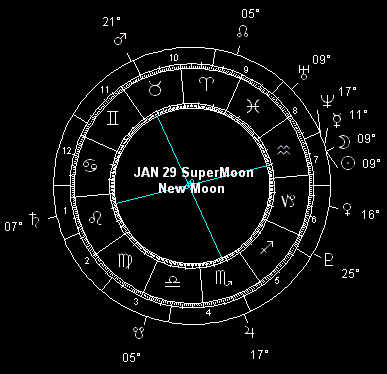 The January 29 SuperMoon geocosmic risk window extends from January 26 through February 3, thanks to a combination of factors including the Moon's south declination maximum on the 27th and northward equatorial crossing on February 2. This particular SuperMoon figures into the year's dominant T-square theme quite literally: it rises in the east, as Saturn sets in the west and Jupiter culminates overhead (opposite Mars, turning the whole thing into a rather loose Grand Cross). In plain English, this means: batten down the hatches. Throughout this period, there will be an increased likelihood of strong storms with high winds and heavy precipitation. Extreme high tides and heavy surf along the coasts, floods, avalanches and mudslides inland, and an elevated risk of moderate to severe seismic activity (Richter 5+ quakes, volcanic eruptions): the news will be full of such. Stay safe and be ready - no matter where you live. You might even want to be extra vigilant and prepared if you'll be in a zone where significant astrological factors are emphasized during this SuperMoon. A look at the astro-locality map points out a number of such hot zones. These include Alaska and the Aleutians, and a north-south zone from the Baja Peninsula and northern Mexico into southern California and Nevada, up through eastern Oregon and Washington and on into Alberta; plus a northeasterly swath that includes Santa Fe, Denver and Bismarck and tops out across southern Greenland before heading west and south through Iceland, Scandinavia, western Russia and Ukraine, down through Turkey and the Middle East. There are also a couple of risky-looking north-south lines that cut through Afghanistan and Pakistan, another pair across eastern Japan, and a whole gaggle of them converging on Papua New Guinea and eastern Australia.
The January 29 SuperMoon geocosmic risk window extends from January 26 through February 3, thanks to a combination of factors including the Moon's south declination maximum on the 27th and northward equatorial crossing on February 2. This particular SuperMoon figures into the year's dominant T-square theme quite literally: it rises in the east, as Saturn sets in the west and Jupiter culminates overhead (opposite Mars, turning the whole thing into a rather loose Grand Cross). In plain English, this means: batten down the hatches. Throughout this period, there will be an increased likelihood of strong storms with high winds and heavy precipitation. Extreme high tides and heavy surf along the coasts, floods, avalanches and mudslides inland, and an elevated risk of moderate to severe seismic activity (Richter 5+ quakes, volcanic eruptions): the news will be full of such. Stay safe and be ready - no matter where you live. You might even want to be extra vigilant and prepared if you'll be in a zone where significant astrological factors are emphasized during this SuperMoon. A look at the astro-locality map points out a number of such hot zones. These include Alaska and the Aleutians, and a north-south zone from the Baja Peninsula and northern Mexico into southern California and Nevada, up through eastern Oregon and Washington and on into Alberta; plus a northeasterly swath that includes Santa Fe, Denver and Bismarck and tops out across southern Greenland before heading west and south through Iceland, Scandinavia, western Russia and Ukraine, down through Turkey and the Middle East. There are also a couple of risky-looking north-south lines that cut through Afghanistan and Pakistan, another pair across eastern Japan, and a whole gaggle of them converging on Papua New Guinea and eastern Australia.
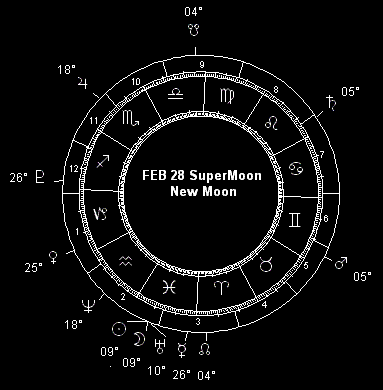 Monstrously powerful windstorms appear to be the strong suit of the February 28 SuperMoon, but the normal meteorological and seismic risks apply. This thing stirs up Planet Earth's crust, atmosphere and oceans from February 21 to March 3 (following the Moon's February 23 south declination extreme). SuperMoons are planetary in scale, so there's no place on Earth that's beyond the reach of disturbances in the sea and sky and crust of our home planet during the February 21-March 3 geocosmic stress window. In seismically active areas, an upsurge in moderate to severe earthquakes (Richter 5 and up) and volcanic eruptions would be par for the course at times like this. Coastal interests should prepare for higher than normal tides and heavy surf. Inland flooding, landslides and avalanches due to unusually heavy precipitation can happen over wide areas, wherever storms can reach - which is to say, just about anywhere at all. Still, the Great Plains from Alberta down through Texas and into central eastern Mexico are one of the major astro-locality high risk sectors for this SuperMoon; also the Aleutian Islands and a north-south swath from central Greenland down through the eastern tip of Brazil and, on the other side of the world, from eastern Australia and Papua New Guinea up through eastern Japan. Another north-south danger zone runs right through Delhi, another goes from Edinburgh down through Madrid and across West Africa, and the last of the major north-south risk lines for the February 28 SuperMoon runs through Wellington, New Zealand. And finally, there's an arc of instability that runs northeasterly through western Africa, across the Mediterranean and Florence, through eastern Europe and across northern Russia, curving southward to cross northern Japan and then into the Pacific.
Monstrously powerful windstorms appear to be the strong suit of the February 28 SuperMoon, but the normal meteorological and seismic risks apply. This thing stirs up Planet Earth's crust, atmosphere and oceans from February 21 to March 3 (following the Moon's February 23 south declination extreme). SuperMoons are planetary in scale, so there's no place on Earth that's beyond the reach of disturbances in the sea and sky and crust of our home planet during the February 21-March 3 geocosmic stress window. In seismically active areas, an upsurge in moderate to severe earthquakes (Richter 5 and up) and volcanic eruptions would be par for the course at times like this. Coastal interests should prepare for higher than normal tides and heavy surf. Inland flooding, landslides and avalanches due to unusually heavy precipitation can happen over wide areas, wherever storms can reach - which is to say, just about anywhere at all. Still, the Great Plains from Alberta down through Texas and into central eastern Mexico are one of the major astro-locality high risk sectors for this SuperMoon; also the Aleutian Islands and a north-south swath from central Greenland down through the eastern tip of Brazil and, on the other side of the world, from eastern Australia and Papua New Guinea up through eastern Japan. Another north-south danger zone runs right through Delhi, another goes from Edinburgh down through Madrid and across West Africa, and the last of the major north-south risk lines for the February 28 SuperMoon runs through Wellington, New Zealand. And finally, there's an arc of instability that runs northeasterly through western Africa, across the Mediterranean and Florence, through eastern Europe and across northern Russia, curving southward to cross northern Japan and then into the Pacific.
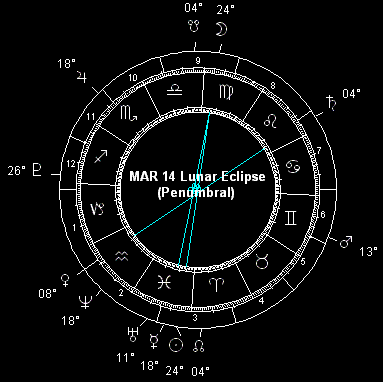 The year's first eclipse is of the lunar variety, on March 14 at 24° 15'Virgo. It's a relatively rare penumbral eclipse, even rarer because it's also total. In a penumbral eclipse the Moon passes through Earth's half-shadow (the penumbra), rather than through the total dark of the full-shadow cone (the umbra) cast by the Sun. Consequently, instead of disappearing as the full shadow of the Earth passes across it, the lunar disk becomes dusky in appearance when Earth's penumbra crosses its face. This particular eclipse is the 63rd of 71 in Saros Series 113, which began in the year 888. Greenland, Iceland, eastern Brazil, Africa and Europe are prime territory for this eclipse, which can be seen from beginning to end here - weather permitting, and in many cases the storm-driven clouds will get in the way. Heavy precipitation and unusually high tides appear to be a hallmark of this alignment, but it also carries a signature suggesting notable seismic activity (Richter 5+ quakes, as well as volcanic eruptions) and powerful electrical storms. Transportation, power and communications networks are especially susceptible to weather-related (and to a lesser extent, seismic-related) disruption during the eclipse, which is part of a geocosmic stress window that stretches from the 11th through the 17th. Although the risk of meteorological and seismic outbursts is planet-wide during this interval, astro-mapping suggests special risk zones in west Central Africa and Central Europe, along an arc from Athens through Bucharest and Kiev; and from Ontario down through Florida, across western Cuba and Central America, and along the coast of northwestern South America; a third arc sweeps up from Indonesia through Thailand, central China and Mongolia.
The year's first eclipse is of the lunar variety, on March 14 at 24° 15'Virgo. It's a relatively rare penumbral eclipse, even rarer because it's also total. In a penumbral eclipse the Moon passes through Earth's half-shadow (the penumbra), rather than through the total dark of the full-shadow cone (the umbra) cast by the Sun. Consequently, instead of disappearing as the full shadow of the Earth passes across it, the lunar disk becomes dusky in appearance when Earth's penumbra crosses its face. This particular eclipse is the 63rd of 71 in Saros Series 113, which began in the year 888. Greenland, Iceland, eastern Brazil, Africa and Europe are prime territory for this eclipse, which can be seen from beginning to end here - weather permitting, and in many cases the storm-driven clouds will get in the way. Heavy precipitation and unusually high tides appear to be a hallmark of this alignment, but it also carries a signature suggesting notable seismic activity (Richter 5+ quakes, as well as volcanic eruptions) and powerful electrical storms. Transportation, power and communications networks are especially susceptible to weather-related (and to a lesser extent, seismic-related) disruption during the eclipse, which is part of a geocosmic stress window that stretches from the 11th through the 17th. Although the risk of meteorological and seismic outbursts is planet-wide during this interval, astro-mapping suggests special risk zones in west Central Africa and Central Europe, along an arc from Athens through Bucharest and Kiev; and from Ontario down through Florida, across western Cuba and Central America, and along the coast of northwestern South America; a third arc sweeps up from Indonesia through Thailand, central China and Mongolia.
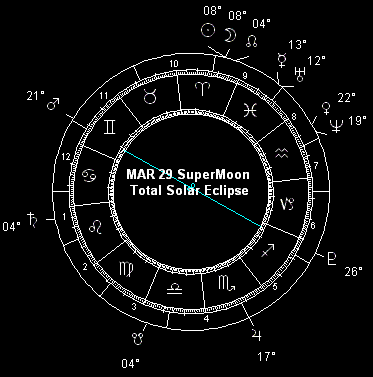 Solar eclipses are always worth an extra look, if only because the geocosmic stress window associated with them is so much larger than that of an ordinary new or full moon, or even an ordinary lunar eclipse or SuperMoon. The March 29 SuperMoon total solar eclipse has an associated storm and seismic risk period that runs from March 21 through April 5, including as it does not only the perigee-syzygy but also the Moon's south declination peak on March 22, its northward equatorial crossing on the 28th, and the April 4 lunar north declination extreme. This period includes the highest lunar declination extremes of the year: 28°S43' on March 22, and 28°N43' on April 4 - although these marks will be tied in September. The combination of all these factors suggests this period has the potential to bring some of the year's most powerful storms, tidal surges, earthquakes and volcanic eruptions. Wind-driven wildfires are likely to make the news in a big way during this risk window - an obvious threat to life and property, and in the latter regard to power, communication and transportation infrastructure in particular. This particular eclipse is the 29th of 71 belonging to Saros Series 139, which began on May 17, 1501 and continues until July 3, 2763. (The first total eclipse of the series occurred on December 21, 1843 - a matter of months before the Bank Charter Act put England on the gold standard.) Its path of totality extends from eastern Brazil, across the Atlantic to North Africa and into central Asia. This zone of visibility is the first place to look for tidal, storm and seismic activity during the March 21-April 5 risk window. But the whole of Planet Earth is subject to this phenomenon, so people everywhere would do well to be on the alert. Astro-mapping may offer some hints to areas of special vulnerability outside the eclipse zone: Alaska and Hawaii and the Pacific coast of Canada; the southwestern US and the northern plains; along a north-south line running pole to pole through Miami in the western hemisphere and Bangkok in the east, as well as another north-south line through Melbourne, Australia; and one running through Johannesburg up across the Mediterranean and western Russia. And then there are the remaining arcs, one that runs southeasterly from northwest Africa down through South Africa, then sweeping northeasterly just off the west coast of New Zealand; another that traverses Scandinavia, western Russia and Ukraine to cross Turkey, the Middle East and the Horn of Africa; and lastly the Sun-Moon horizon line that arcs up from Perth to Shanghai.
Solar eclipses are always worth an extra look, if only because the geocosmic stress window associated with them is so much larger than that of an ordinary new or full moon, or even an ordinary lunar eclipse or SuperMoon. The March 29 SuperMoon total solar eclipse has an associated storm and seismic risk period that runs from March 21 through April 5, including as it does not only the perigee-syzygy but also the Moon's south declination peak on March 22, its northward equatorial crossing on the 28th, and the April 4 lunar north declination extreme. This period includes the highest lunar declination extremes of the year: 28°S43' on March 22, and 28°N43' on April 4 - although these marks will be tied in September. The combination of all these factors suggests this period has the potential to bring some of the year's most powerful storms, tidal surges, earthquakes and volcanic eruptions. Wind-driven wildfires are likely to make the news in a big way during this risk window - an obvious threat to life and property, and in the latter regard to power, communication and transportation infrastructure in particular. This particular eclipse is the 29th of 71 belonging to Saros Series 139, which began on May 17, 1501 and continues until July 3, 2763. (The first total eclipse of the series occurred on December 21, 1843 - a matter of months before the Bank Charter Act put England on the gold standard.) Its path of totality extends from eastern Brazil, across the Atlantic to North Africa and into central Asia. This zone of visibility is the first place to look for tidal, storm and seismic activity during the March 21-April 5 risk window. But the whole of Planet Earth is subject to this phenomenon, so people everywhere would do well to be on the alert. Astro-mapping may offer some hints to areas of special vulnerability outside the eclipse zone: Alaska and Hawaii and the Pacific coast of Canada; the southwestern US and the northern plains; along a north-south line running pole to pole through Miami in the western hemisphere and Bangkok in the east, as well as another north-south line through Melbourne, Australia; and one running through Johannesburg up across the Mediterranean and western Russia. And then there are the remaining arcs, one that runs southeasterly from northwest Africa down through South Africa, then sweeping northeasterly just off the west coast of New Zealand; another that traverses Scandinavia, western Russia and Ukraine to cross Turkey, the Middle East and the Horn of Africa; and lastly the Sun-Moon horizon line that arcs up from Perth to Shanghai.
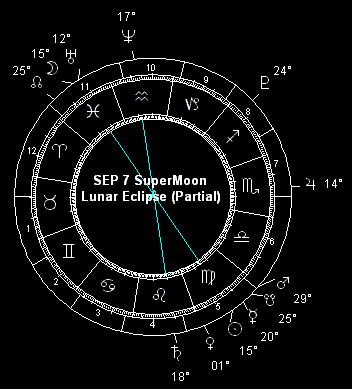 The September 7 SuperMoon partial lunar eclipse is number 51 of 74 in Saros Series 118, which began on March 2, 1105 and concludes on May 17, 2421. The entire eclipse will be visible from east Africa, Eastern Europe, the Middle East, most of Asia, much of the South Pacific and Western Australia. This eclipse's geocosmic risk window extends from the 4th through the 10th, and it's sandwiched right between a pair of strong storm and seismic indicators on the 2nd and the 15th (the Moon's south and north declination extremes, respectively). Moreover, the September 22 annular solar eclipse opens up a wider geocosmic stress zone that runs from the 13th through the end of the month, and includes the year's highest north (on the 15th) and south (on the 29th) lunar declination extremes. (These two tie the marks set on March 22 and April 4.) This same period sees the year's emblematic T-square drawing to within a few degrees of exact all around - and in the same degrees (though different signs) as the eclipse. All things considered, September looks unusually active on the storm and seismic front, and the SuperMoon partial lunar eclipse on the 7th appears to get the wrecking ball rolling.
The September 7 SuperMoon partial lunar eclipse is number 51 of 74 in Saros Series 118, which began on March 2, 1105 and concludes on May 17, 2421. The entire eclipse will be visible from east Africa, Eastern Europe, the Middle East, most of Asia, much of the South Pacific and Western Australia. This eclipse's geocosmic risk window extends from the 4th through the 10th, and it's sandwiched right between a pair of strong storm and seismic indicators on the 2nd and the 15th (the Moon's south and north declination extremes, respectively). Moreover, the September 22 annular solar eclipse opens up a wider geocosmic stress zone that runs from the 13th through the end of the month, and includes the year's highest north (on the 15th) and south (on the 29th) lunar declination extremes. (These two tie the marks set on March 22 and April 4.) This same period sees the year's emblematic T-square drawing to within a few degrees of exact all around - and in the same degrees (though different signs) as the eclipse. All things considered, September looks unusually active on the storm and seismic front, and the SuperMoon partial lunar eclipse on the 7th appears to get the wrecking ball rolling.
Being planetary in scale, there's no place on Earth beyond the reach of at least some of the SuperMoon arsenal. Obviously the extreme tidal surges and high surf will only be an immediate problem in coastal areas, and moderate to severe (Richter 5 and up) earthquakes and volcanic eruptions aren't going to happen except in fault zones and in the vicinity of volcanoes. But the dangerous weather can strike with high winds and and/or heavy precipitation virtually anywhere on the planet. So be alert, even if you don't live in the eclipse's zone of visibility - and maybe especially if you live under one of the sensitive astro-locality lines for the September 7 eclipse. These include a number of pole to pole north-south lines: one running through Mexico City in the western hemisphere and Delhi in the east, another through British Columbia in the west and Tehran in the east, a third through Chicago in the west and western Mongolia in the east, and a fourth through Rio de Janeiro in the west and Japan, Indonesia and Australia (around Alice Springs) in the east. There's also a series of danger arcs, one sweeping northeasterly from San Francisco up through Edmonton, across central Greenland, and then turning southeasterly to cross Scandinavia and pass through eastern Europe, Turkey and the Middle East, across the Horn of Africa and Madagascar; another through Rio de Janeiro (crossing the Jupiter meridian line there), sweeping northeasterly from there to pass offshore of Scandinavia and then turn southeasterly to pass down through Russia, eastern China, North Korea, southern Japan, Papua New Guinea and eastern Australia; and finally an arc from west Africa through Spain and England, across the Arctic and down through New Zealand.
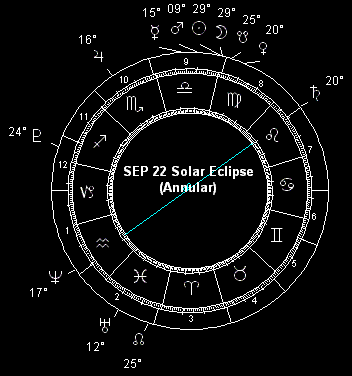 The crust, sea and skies of Planet Earth won't settle down much in September, what with the annular solar eclipse on the 22nd, which occurs within hours of the autumnal equinox and therefore features the Moon crossing the celestial equator (in this case, from north to south). This is the 16th of 70 eclipses comprising Saros Series 144, which runs from April 11, 1736 to May 5, 2980. The geocosmic stress window of this eclipse stretches from the 13th through the end of the month, includes one of the year's highest lunar declination extremes, and occurs as the year's emblematic T-square remains within a few degrees of exact all around. You should know the drill by now: get ready for strong storms with high winds and/or heavy precipitation (in some cases causing flooding, mudslides, avalanches and the like), maximal tidal surges and heavy surf along the coasts, and moderate to severe (Richter 5+) disturbances in seismically active regions - including volcanic eruptions. Being planetary in scale, there's no place on Planet Earth beyond the reach of one or more of these phenomena. The risk may be heightened in the areas where the eclipse is visible, which is limited to northern South America in terms of land masses where the full annular eclipse is visible. Other risk zones suggested by astro-locality mapping include a number of pole to pole north-south zones: one from the Bering Straits in the eastern hemisphere to western Europe and west central Africa in the west; another running from San Salvador through New Orleans and Chicago in the west and Dhaka, Bangladesh in the east; another from the Yukon and British Columbia in the western hemisphere, through Japan, Papua New Guinea and Melbourne in the east. Alaska and the Aleutians are under another danger arc, which sweeps across Madagascar and up through the Middle East and Central Asia; another such arc runs over Argentina and Brazil, crosses the Atlantic and comes down through eastern China, Indonesia and eastern Australia; and finally, there's a Mars horizon line that arcs over Quito, Panama City, eastern Cuba, Washington DC and Quebec in the Americas, crossing Russia, central Mongolia and China to pass through Bangkok, Malaysia and western Indonesia in the eastern hemisphere.
The crust, sea and skies of Planet Earth won't settle down much in September, what with the annular solar eclipse on the 22nd, which occurs within hours of the autumnal equinox and therefore features the Moon crossing the celestial equator (in this case, from north to south). This is the 16th of 70 eclipses comprising Saros Series 144, which runs from April 11, 1736 to May 5, 2980. The geocosmic stress window of this eclipse stretches from the 13th through the end of the month, includes one of the year's highest lunar declination extremes, and occurs as the year's emblematic T-square remains within a few degrees of exact all around. You should know the drill by now: get ready for strong storms with high winds and/or heavy precipitation (in some cases causing flooding, mudslides, avalanches and the like), maximal tidal surges and heavy surf along the coasts, and moderate to severe (Richter 5+) disturbances in seismically active regions - including volcanic eruptions. Being planetary in scale, there's no place on Planet Earth beyond the reach of one or more of these phenomena. The risk may be heightened in the areas where the eclipse is visible, which is limited to northern South America in terms of land masses where the full annular eclipse is visible. Other risk zones suggested by astro-locality mapping include a number of pole to pole north-south zones: one from the Bering Straits in the eastern hemisphere to western Europe and west central Africa in the west; another running from San Salvador through New Orleans and Chicago in the west and Dhaka, Bangladesh in the east; another from the Yukon and British Columbia in the western hemisphere, through Japan, Papua New Guinea and Melbourne in the east. Alaska and the Aleutians are under another danger arc, which sweeps across Madagascar and up through the Middle East and Central Asia; another such arc runs over Argentina and Brazil, crosses the Atlantic and comes down through eastern China, Indonesia and eastern Australia; and finally, there's a Mars horizon line that arcs over Quito, Panama City, eastern Cuba, Washington DC and Quebec in the Americas, crossing Russia, central Mongolia and China to pass through Bangkok, Malaysia and western Indonesia in the eastern hemisphere.
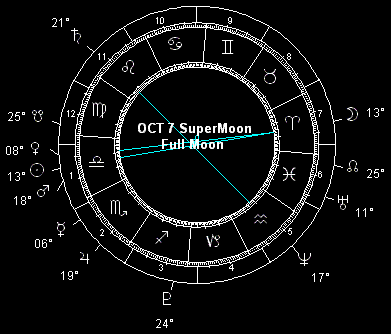 Last among the major syzygies of the year is the October 7 SuperMoon full moon, which anchors a geocosmic stress window extending from the 4th through the 13th, including the Moon's northward equatorial crossing on the 6th and north declination peak on the 12th. Still within just a couple degrees of exact during this SuperMoon, the year's signature T-square is a reminder that this is no mere patch of stormy weather. Get ready for the big guns: dangerous storms with high winds and heavy precipitation threaten flooding, damaged or disrupted infrastructure (including highways and power grids as well as air and sea lanes); also high tidal surges and heavy surf along the coasts, and moderate to severe temblors (Richter 5+) and volcanic eruptions in seismically active areas. These risks apply worldwide of course, but astro-locality mapping does suggest a few target zones. For instance, there's a north-south zone that runs through central Mexico and the Great Plains in the New World, down through Russia, western China and central India in the Old. Another north-south zone stretches from eastern Brazil and western central Greenland in the western hemisphere, down through eastern Russia and China, the Korean Peninsula, Japan, Indonesia and central Australia. Last among the north-south high risk sectors is one that runs from Iceland down across the westernmost coast of Africa, reaching around to the other side of the globe to cross in the vicinity of Vanuatu and New Caledonia, running from there northward across the Kamchatka Peninsula.
Last among the major syzygies of the year is the October 7 SuperMoon full moon, which anchors a geocosmic stress window extending from the 4th through the 13th, including the Moon's northward equatorial crossing on the 6th and north declination peak on the 12th. Still within just a couple degrees of exact during this SuperMoon, the year's signature T-square is a reminder that this is no mere patch of stormy weather. Get ready for the big guns: dangerous storms with high winds and heavy precipitation threaten flooding, damaged or disrupted infrastructure (including highways and power grids as well as air and sea lanes); also high tidal surges and heavy surf along the coasts, and moderate to severe temblors (Richter 5+) and volcanic eruptions in seismically active areas. These risks apply worldwide of course, but astro-locality mapping does suggest a few target zones. For instance, there's a north-south zone that runs through central Mexico and the Great Plains in the New World, down through Russia, western China and central India in the Old. Another north-south zone stretches from eastern Brazil and western central Greenland in the western hemisphere, down through eastern Russia and China, the Korean Peninsula, Japan, Indonesia and central Australia. Last among the north-south high risk sectors is one that runs from Iceland down across the westernmost coast of Africa, reaching around to the other side of the globe to cross in the vicinity of Vanuatu and New Caledonia, running from there northward across the Kamchatka Peninsula.
SuperMoons and eclipses are not the only celestial phenomena to turn up every year. Another familiar annual theme involves the cycles of Mercury. Being closest to the Sun, Mercury goes intersolar as seen from Earth more than any other planet; several times a year in fact, including the infamous Mercury retrogrades of astrological legend. While most astrologers pay a fair amount of attention to Mercury's retrograde, few realize that it's only a part of the more fundamental intersolar phase in the orbital interaction between Mercury and Earth, as they both orbit around the Sun.
 Mercury's intersolar phase begins when the little Sun-grazer reaches its maximum elongation east of the Sun - its evening star phase. This happens when Mercury has come 'round to the same side of the Sun as Planet Earth, and is relatively near us. The little planet is then pulling up to pass Earth on the inside track, as it were; catching up to us from behind and then passing between us and the Sun. Just as it catches up with us, Mercury passes directly between Earth and the Sun. This is Mercury's inferior conjunction with the Sun. Sometimes, when Earth and Mercury and the Sun are all very perfectly aligned - which happens only about thirteen times per century - this inferior conjunction is also a transit of the little planet across the face of the Sun. (Such a transit occurs this year, for the first time since 2003.) After the inferior conjunction, Mercury continues pulling ahead of us until it reaches its greatest elongation west of the Sun (its morning star phase), at which point the little planet is headed toward the far side of our parent star. Between these two extremes, the greatest east and west elongations, comes the fabled Mercury retrograde period of astrological lore.
Mercury's intersolar phase begins when the little Sun-grazer reaches its maximum elongation east of the Sun - its evening star phase. This happens when Mercury has come 'round to the same side of the Sun as Planet Earth, and is relatively near us. The little planet is then pulling up to pass Earth on the inside track, as it were; catching up to us from behind and then passing between us and the Sun. Just as it catches up with us, Mercury passes directly between Earth and the Sun. This is Mercury's inferior conjunction with the Sun. Sometimes, when Earth and Mercury and the Sun are all very perfectly aligned - which happens only about thirteen times per century - this inferior conjunction is also a transit of the little planet across the face of the Sun. (Such a transit occurs this year, for the first time since 2003.) After the inferior conjunction, Mercury continues pulling ahead of us until it reaches its greatest elongation west of the Sun (its morning star phase), at which point the little planet is headed toward the far side of our parent star. Between these two extremes, the greatest east and west elongations, comes the fabled Mercury retrograde period of astrological lore.
Retrograde means moving backwards, which is what Mercury appears to do in our skies when the little inner planet catches up on us and passes us on the inside, between Earth and the Sun. First Mercury reaches its greatest eastern elongation, then it appears to stand still in the sky (the retrograde station), and then it appears to move backwards through the heavens for a period of several weeks: that's Mercury retrograde for you. It ends when the little Sun-grazer's backwards motion comes to an apparent halt (the direct station); after which, Mercury moves forward again, until it reaches its maximum elongation west of the Sun. The reality of course is that Mercury never stops in its orbit, and never moves backward: this is only how the relative motions of Earth and Mercury around the Sun cause Mercury to move through our night sky.
Mercury retrograde is the cycle when everything goes wrong, to hear some astrologers tell it. The truth is not so simple-minded. All things Mercurial are crucial during the intersolar Mercury phase; infrastructure, commerce, information, communication and transport being prime examples. Absent careful investigation and planning, and conscientious follow-through, all such things are apt to go off track during these cycles. There is "a time to every purpose under heaven," as the Preacher wrote (Ecclesiastes 3:1). Mercury's intersolar phase is a time for focus, concentration, planning, follow-through and communication - all the qualities of the active and involved mind, in short. In case you haven't noticed, most people are not especially alert and focused most of the time. When this kind of sleepwalking runs into Mercury's intersolar cycle, with its focus on mental acuity, it doesn't take long for things to go awry. If you're sharp and focused and alert, you can avoid a certain amount of this mess. In fact, you can even prosper by concentrating on tasks that center on thought, planning and communication. But you'll still have to dodge all the messes created by the people who are sleepwalking. So be ready.
Among the sort of things to be ready for during the above mentioned Mercury intersolar cycles: strikes and other disruptions affecting transportation and communication (e.g. postal, phone, mass transit, trucking, airline, shipping, dock and warehouse workers, teachers and all manner of media). Weather both terrestrial and solar (including geomagnetic storms) can play a part in the kind of breakdowns described here, but human effort (and sometimes malicious action) is a part of the mix as well. Power failures due to infrastructure breakdown and computer network disruptions caused by hacker attacks, software vulnerabilities and the like are also just a crossed wire or a keystroke away from a major mess at these times.
If I had to pick a day to have a backup generator all fueled up and ready to go, a backup plan in place in case the scheduled or expected didn't come to pass, a day to be especially sharp and steady and focused - it would be during one of these Mercury cycles. Note these dates; be ready with a fallback plan just in case. It's not so much that disaster is destined to strike when Mercury is in its intersolar phase. Rather, it's that everything pertaining to Mercury becomes crucial; and unless it's treated as such, then it goes awry. Unfortunately, few people keep their eye on the ball with any consistency and diligence. And that's the reason these Mercury cycles tend to turn into Murphy's Law festivals. Don't say I didn't warn you!
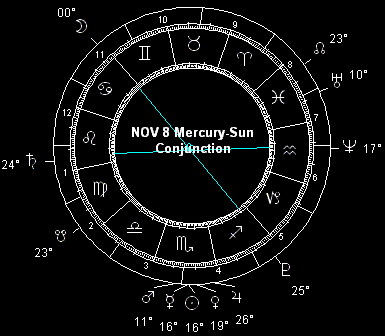 The first intersolar Mercury phase of 2006 begins with the little planet's maximum elongation eastward on February 24, includes the March 2-25 retrograde and the March 12 inferior conjunction with the Sun, and ends with Mercury's greatest western elongation on April 8. Next comes the June 20 greatest eastern elongation, initiating a Mercury intersolar cycle which includes the July 4-29 retrograde and the July 18 inferior conjunction, and concludes with the August 6 western elongation maximum. Finally this year there's the Mercury intersolar phase that starts with the maximum eastern elongation on October 17, includes the October 28-November 18 retrograde and the November 8 inferior conjunction, and wraps up with the western elongation extreme on November 25. This last phase is of special interest, because it includes the first Mercury transit across the solar disk since 2003. (There won't be another until 2016.)
The first intersolar Mercury phase of 2006 begins with the little planet's maximum elongation eastward on February 24, includes the March 2-25 retrograde and the March 12 inferior conjunction with the Sun, and ends with Mercury's greatest western elongation on April 8. Next comes the June 20 greatest eastern elongation, initiating a Mercury intersolar cycle which includes the July 4-29 retrograde and the July 18 inferior conjunction, and concludes with the August 6 western elongation maximum. Finally this year there's the Mercury intersolar phase that starts with the maximum eastern elongation on October 17, includes the October 28-November 18 retrograde and the November 8 inferior conjunction, and wraps up with the western elongation extreme on November 25. This last phase is of special interest, because it includes the first Mercury transit across the solar disk since 2003. (There won't be another until 2016.)
A Mercury transit across the face of the Sun is a rare and special kind of inferior conjunction. All inferior conjunctions occur when Mercury passes directly between Earth and Sun. (A superior conjunction, on the other hand, takes place when Earth, Sun and Mercury are aligned with Mercury on the far side of the Sun from us.) If Earth and Mercury orbited in the same plane, every inferior conjunction would be a solar transit. However Mercury's orbit is inclined by seven degrees to Earth's orbital plane (viz. the ecliptic), so it's the rare inferior conjunction which takes place with Earth and Mercury being in the same plane at the same time they're lined up with the Sun. In a typical year, there are three inferior conjunctions of Mercury and the Sun. In a typical century, out of several hundred of those inferior conjunctions, there are only about thirteen solar transits of Mercury.
Since Columbus set sail for the Americas, and for the next 1,500 years or so, solar transits of Mercury can only occur in May and November. Currently, the May transit happens around the 8th - its aphelion transit, when Mercury is farthest from the Sun. The November transit occurs around the 11th - it's the perihelion transit, when Mercury is nearest the Sun. Nowadays, those dates put the solar transit around the middle of the fixed signs Taurus and Scorpio, respectively. (November transits recur at intervals of 7, 13 or 33 years; while May transits recur at intervals of 13 or 33 years.)
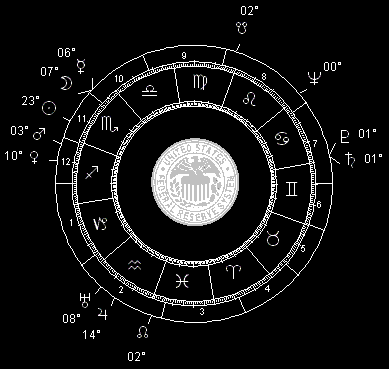 This year's transit takes place during the November 8 inferior conjunction, at 16° 20' Scorpio; which just happens to be in the range of the year's hallmark T-square. It belongs to a series of 19 Mercury transits which began in 1776 and concludes in 2604, according to a system expounded by NASA astrophysicist Fred Espenak. (Espenak's system is analogous to the Saros Cycle, but applies to Mercury transits instead of eclipses.) There was a solar transit in this series on November 7, 1914 - nine days before the US Federal Reserve opened for business. Although there have been thirteen Mercury transits between then and now, only one belonged to the same series as the 2006 event. It happened on November 7, 1960 - within a day of the US Presidential election that put John Kennedy in the White House.
This year's transit takes place during the November 8 inferior conjunction, at 16° 20' Scorpio; which just happens to be in the range of the year's hallmark T-square. It belongs to a series of 19 Mercury transits which began in 1776 and concludes in 2604, according to a system expounded by NASA astrophysicist Fred Espenak. (Espenak's system is analogous to the Saros Cycle, but applies to Mercury transits instead of eclipses.) There was a solar transit in this series on November 7, 1914 - nine days before the US Federal Reserve opened for business. Although there have been thirteen Mercury transits between then and now, only one belonged to the same series as the 2006 event. It happened on November 7, 1960 - within a day of the US Presidential election that put John Kennedy in the White House.
I figure that the rare solar transit makes this year's October 17-November 25 intersolar Mercury cycle especially dramatic. It heralds labor strife (strikes, pickets, etc.), infrastructure breakdowns (including power, rail, highways, air travel and satellite systems); automatic system failures (including safety systems in vehicles, aircraft, and marine vessels); and most especially computer-related messes (from hacker attacks and network outages to software flaws to lawsuits and other legal actions against computer hardware and software makers). True, these things are not uncommon anytime Mercury is intersolar. We're just due for a bigger, 'badder' batch this time around. In particular, watch for (and guard against) major Murphy's Law stuff around the full moon on November 5, with its Sun-Mercury-Venus-Mars-Jupiter stellium in Scorpio and of course the year's big T-square still hanging around. (Don't be surprised by a big reversal in the US dollar versus the Euro and other currencies sometime between about November 4 and the end of the year.)
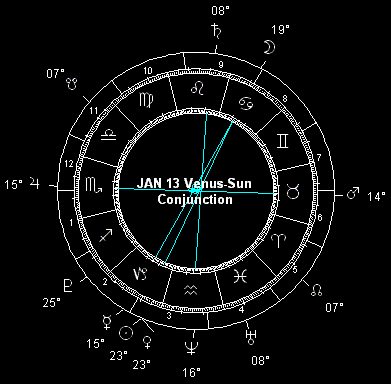 The two planets that orbit the Sun inside Earth's own orbit are, by definition, the only ones that can have an intersolar cycle as seen from our home planet. While Mercury goes intersolar on us several times every year, Venus only does it once every other year. The current Venus intersolar cycle began November 3, 2005 as the "evening star" (Venus Vesper) attained maximum elongation east of the Sun. The cycle continues through Venus' retrograde (backwards motion as seen from Earth), which lasts from December 24, 2005 through February 3, 2006. It reaches perhaps its most intensive phase when Venus makes its inferior conjunction to the Sun on January 13, 2006; when Earth, Venus and Sun are all lined up with Venus between Earth and Sun. And the cycle wraps up on March 25, 2006, as Venus Lucifer (the "morning star") attains maximum elongation west of the Sun and passes behind the plane of the Sun as seen from Earth.
The two planets that orbit the Sun inside Earth's own orbit are, by definition, the only ones that can have an intersolar cycle as seen from our home planet. While Mercury goes intersolar on us several times every year, Venus only does it once every other year. The current Venus intersolar cycle began November 3, 2005 as the "evening star" (Venus Vesper) attained maximum elongation east of the Sun. The cycle continues through Venus' retrograde (backwards motion as seen from Earth), which lasts from December 24, 2005 through February 3, 2006. It reaches perhaps its most intensive phase when Venus makes its inferior conjunction to the Sun on January 13, 2006; when Earth, Venus and Sun are all lined up with Venus between Earth and Sun. And the cycle wraps up on March 25, 2006, as Venus Lucifer (the "morning star") attains maximum elongation west of the Sun and passes behind the plane of the Sun as seen from Earth.
As I predicted in my World Forecast Highlights for last year, the current Venus intersolar cycle coincided with "an undercurrent of economic growth" in late 2005. Expect it to continue into early 2006. This is especially good for copper, gold and silver; for jewelry and fashion, for the entertainment industry. (Gold has been a complicated proposition, what with favorable lunar declination factors and an unfavorable Saturn transit.) Remember, as mentioned when discussing the favorable associations of the Venus intersolar cycle for last year's forecast, that "there are other indicators of a less favorable nature, so no one should expect unmitigated economic and financial improvement on a broad scale. Horrid oil price shocks will play havoc with the world economy off and on." This is even more the case in 2006, so make hay while Venus remains between us and the Sun. By late March, what favorable economic tides there have been, are beginning to ebb - just as the benefic Venus cycle itself fades away. Blue chips in general and financials in particular (also mines) look strong in January and February. By the time high tech equities take off in early March, it's time to cash out and get to the sidelines for a while. (Just remember what cash really is - and what's really cash.) In June, when Venus in Taurus turns the Saturn-Jupiter-Neptune T-square into a Grand Cross, I expect a crisis of confidence to disrupt the currency, equity and financial markets in no small way.
With the Red Planet fading as Earth pulls away from its close encounter with Mars in late 2005, 2006 in some ways looks like a more peaceful, less violent time overall than the year before. Prominent Mars years, when Earth and Mars are relatively near each other, come once every two years, give or take a month or so. They correspond to the Sun-Mars opposition, which occurred in 2001 (a few months before the 9/11 attack) and in 2003 (as the insurgency phase got underway in Gulf War II).
The latter Mars alignment was historic, the closest pass between Earth and Mars since Neanderthals were stargazing. It was chief among the factors that led to my 2003 World Forecast prediction that Persian Gulf War II would break out that year, and then get really messy that summer: "Whoever thinks a swiftly concluded Persian Gulf War II settles the world into a Pax Americana early in 2003 is tragically mistaken. This late summer super Mars thing says peace and quiet remains far away, that danger and conflict are close at hand." The 2005 Mars perigee (closest approach to Earth), though not as extreme as that of 2003, was still unusually close. And last year saw plenty of wildfire disasters and fiery crashes, terror attacks and other violent criminality, explosions and military conflicts - the whole war and rumors of war thing. As predicted, 2005 made 2004 "look relatively calm and peaceful."
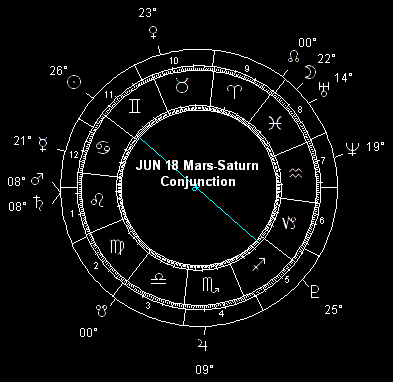 While 2006 looks like a time of relative peace and quiet, now that Mars is shrinking in the night sky, that's not to say that Utopia has arrived - not by a long shot. Humans remain predators, tools and weapons are still dangerous; violence and accidents, fires and explosions and acts of God and other such calamities will still tear limb from limb, leaving ruin in their wake. These things will always be with us. I figure they'll be a little less the main story this year, but we still need to be watchful - particularly within a few days to a week either side of the major Mars alignments of 2006. These include the opposition (January 15) and conjunction (December 12) of Mars and Jupiter, the June 18 Mars-Saturn conjunction (emphasized by the nearly simultaneous Mars square to Jupiter, drawing the Red Planet into the year's emblematic T-square); also the July 5 Mars opposition to Neptune (again, the T-square) and the August 13 opposition to Uranus. Additional danger zones - as always, plus or minus a few days to a week - center around the eclipse-activated degrees the Red Planet transits on August 12 (Mars passes through the degree of the March 3, 2007 lunar eclipse at 13 Virgo), August 29 (Mars reaches 24 Virgo, the degree of the March 14, 2006 lunar eclipse), September 6 (Mars arrives at 29 Virgo, the degree of the September 22, 2006 solar eclipse), and September 23 (when Mars comes to 10 Libra, the degree of the October 3, 2005 solar eclipse).
While 2006 looks like a time of relative peace and quiet, now that Mars is shrinking in the night sky, that's not to say that Utopia has arrived - not by a long shot. Humans remain predators, tools and weapons are still dangerous; violence and accidents, fires and explosions and acts of God and other such calamities will still tear limb from limb, leaving ruin in their wake. These things will always be with us. I figure they'll be a little less the main story this year, but we still need to be watchful - particularly within a few days to a week either side of the major Mars alignments of 2006. These include the opposition (January 15) and conjunction (December 12) of Mars and Jupiter, the June 18 Mars-Saturn conjunction (emphasized by the nearly simultaneous Mars square to Jupiter, drawing the Red Planet into the year's emblematic T-square); also the July 5 Mars opposition to Neptune (again, the T-square) and the August 13 opposition to Uranus. Additional danger zones - as always, plus or minus a few days to a week - center around the eclipse-activated degrees the Red Planet transits on August 12 (Mars passes through the degree of the March 3, 2007 lunar eclipse at 13 Virgo), August 29 (Mars reaches 24 Virgo, the degree of the March 14, 2006 lunar eclipse), September 6 (Mars arrives at 29 Virgo, the degree of the September 22, 2006 solar eclipse), and September 23 (when Mars comes to 10 Libra, the degree of the October 3, 2005 solar eclipse).
These Mars dates are times to be vital, alert and cautious - not paranoid. Pay attention to what you're doing, while you're doing it. Watch out for 'the other guy' - the punch that drops you is always the one you didn't see coming. These are good times to be 'in training' - sharpening the senses and reflexes, strengthening the body and mind. While I'd advise against deliberately going in harm's way during these strong Mars cycles, if you go in ready and alert, you've got a far better chance of coming out okay. Moreover, it's worth making the point that while Mars is a factor in danger and dastardly deeds, it's also the signature of derring-do and the excellent, inspired act of strength, coordination and daring. It's also outrageously sexy, at such times as the Venus-Mars conjunction at 1° Scorpio (October 25). - which can be a welcome diversion if the global financial and political structure is crumbling around us.
ACKNOWLEDGMENTS: All astrological charts as well as eclipse and astro-locality maps were calculated and produced using Matrix Software's WinStar Plus 2.05. Additional astronomical diagrams and calculations were produced with John Walker's HomePlanet 3.1 and Maris Technologies' RedShift 5 software. Fred Espenak's NASA Eclipse Home Page is an indispensable online source of Saros Cycle details. Assorted historical graphs were produced with Microsoft Office Excel 2003. A number of my friends, clients and colleagues have contributed ideas, opinions and data which have helped inform this presentation. Alan Brown and Jim Tate deserve special thanks and recognition in this regard. However the responsibility for the ideas presented here - and any mistakes as well - is solely my own.